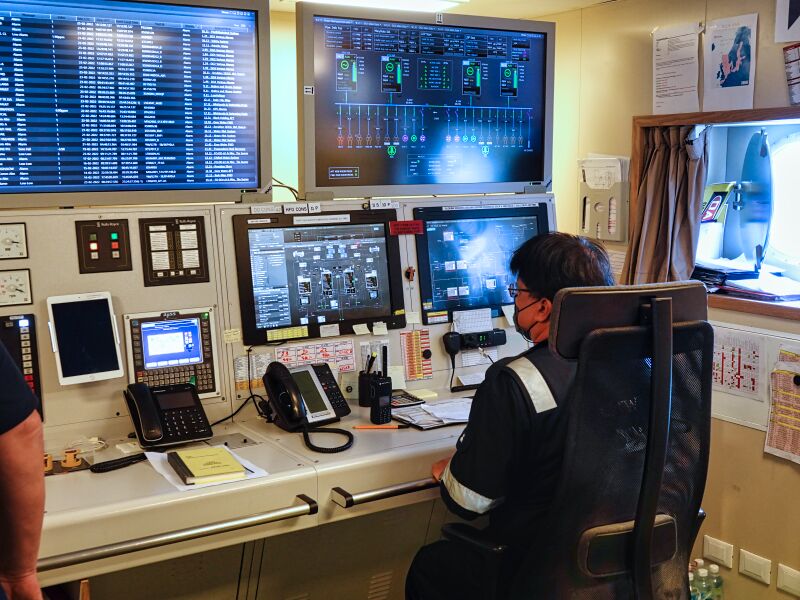Cruise day: 62/152Ports days: 18
Sea days: 44
Countries: 6
Continents: 2
Ports: 11
On this last sea day of our nine-day run from the south end of South America to the Cape Verde Islands, we had the opportunity to visit the engine control room. This is where the magic happens on a cruise ship. Sure, the captain gets all the glory, but without the engine team, the captain would have command of a very large, floating, paperweight.
The engine control room is impressively sized. Huge? Nope - small. Like really small. But, in that tiny room is stuffed all the controls to operate the ship, with the exception of navigation. More on that later.
This is I-95.
Every cruise ship has an I-95. I-95 on a cruise ship is a thoroughfare that exists one floor below the guest floors - in this case, on deck #a, just below deck #1. This straight walkway runs the entire length of the ship and is the most direct route to anywhere on the ship. On deck #a, just off the aft elevators/stairs, and across I-95, we find the engine control room. This is the home base for the engineering team that runs the entire ship. A skilled team of 36 handles all aspects of ship operation and maintenance.
Leading the team is the ship's Chief Engineer, Per. Per is a jovial man with a jovial personality that you wouldn't necessarily expect for someone with the responsibility of keeping the ship running no matter what. With 47 years at sea, he has seen and done just about everything.
Per is assisted by Staff Chief Engineer, Ivo.

Whenever the Star is maneuvering into a port, Per is required to be on duty, supervising the propulsion operations. Whenever the Star is departing a port, Ivo is required to be on duty. The time of day does not matter.
Much like the bridge with a 4-hour-on / 8-hour-off schedule for its watch teams, the engine control room is staffed 24-hours a day on that same schedule. Here, we see the person responsible for monitoring status during the time our tour was conducted.
All aspects of the mechanical operation of the ship are on full display in the engine control room. First, they continuously monitor all of the individual components via camera. In the unlikely event a fire occurs, they can reach it and handle it even before an alarm might sound.
As on the bridge, there is a full set of propulsion controls here in the engine control room. They can take control, or push control back up to the bridge.
In the event of an emergency, there is another control room with all this same control plus navigational control. This room can be secured against entry and the ship can be completely operated from this secure room.
There is a myriad of displays and controls for freshwater production, steam production, propulsion, electrical distribution, air handling, temperature control, intra-ship communication, and engine performance.
 |
| Power management display |
 |
| Current position display with heading |
Here is the speed and stabilizer status display. The ship has two stabilized "wings", one on each side. These are deployed to help smooth the ship's travel through rough seas. Once the ship is going at least 6-knots, the stabilizers become effective in offsetting the ship's roll back and forth. Constantly and automatically adjusted, the stabilizers provide extra lift on a side that is listing downward to slow the roll and provide a smoother sailing experience for the guests.
 |
| Speed and stabilizer status |
 |
| Bilge pump status |
 |
| Public address console |
 |
| One of the two propeller staus displays |
 |
| I didn't get what this console controls, but since the rudders are supplied by Rolls Royce, I'd guess it might have something to do with the rudder system |
 |
| Ventilation control |
On this ship, we produce black water (sewage) and grey water (wastewater). This water is treated on the ship and clarified to the point that it is essentially drinking water. At that point, it can be discharged. The ship can hold 1000 cubic meters (m3) (264,172 gallons) of treated and untreated black water and 1500m3 (396,258 gallons) of treated and untreated grey water.
 |
| Gray water storage and filtration status |
The ship uses steam for a variety of things - heating water, heating cold fuel, and so on. Two oil-fired boilers can produce 6 metric tonnes of steam per hour.
 |
| Boiler status |
What gets everything moving and going are the engines. This display shows inlet and outlet pressure, oil pressure, and other operating parameters.
 |
| Engine status display |
Performance data is regularly gathered and submitted to the manufacturer.
- Father engines (x2)
- 12-cylinder
- 9,011.67 horsepower
- 6,720 kilowatt (kW) output
- Son engines (x2)
- 9-cylinder
- 6,757.75 horsepower
- 5,040 kW output
- Each engine has its own exhaust gas economizer
- All exhaust gas is processed through a dual closed-loop exhaust gas scrubber system so only clean vapor is released
Today was a busy day! Arlona whipped out another set of earrings today in art class.

























Fabulous blog
ReplyDeleteI agree!
DeleteIt looks like Chief Engineer Per may have had blood taken....
ReplyDelete